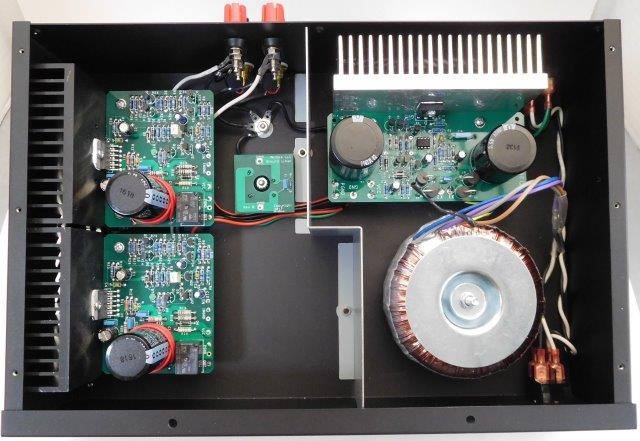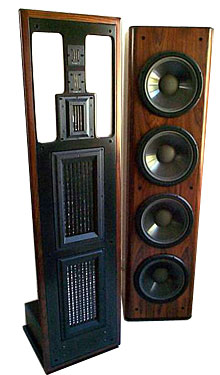Click pic to enlarge. Cover off the TU-8150 for convenience. Input 1 in front is used. Note the Op Amp has been removed from its socket (to the front of the lower/right channel 6V6). Note also the red jumper to the back of the same tube is set to Pentode Mode. The 12AX7 is not on fire - there is a decorating diode underneath.
Review: Elekit TU-8150 (DX), Part II
See Part I for Basic Info. Part III (Smaller Loudspeaker Matching) and Part IV (Input 2 mod) have also been published.
In this article, I tested the Pentode and Triode Modes, and assessed the effects of the Op Amp as well as the difference between Inputs 1 and 2. All using 6V6 and System II (Shindo Monbrisson preamp; for details see Part I). You will notice that I played exclusively LP's for these sessions, so any lack of power should have been instantly evident. High Impedance Earphones, Tweaks and Potential Mods are addressed.
:format(jpeg):mode_rgb():quality(40)/discogs-images/R-7567603-1509543901-5911.jpeg.jpg) Listening
Listening- Pentode Mode vs Ultralinear Mode In later vintage and modern tube amps, the pentodes are frequently run in Ultralinear Mode (all Mullard 5-20 and Williamson's types are). The reasons are complex and I am not equipped to go into it, but if you google "Pentode vs Ultralinear" you will find a huge amount of basic info as well as discussion out there, some heated. Suffice to say there is a pentode mode revival of sort and there is no consensus on which mode sounds better. While Elekit recommends Ultralinear (same power output as pentode; 2.9 WPC), my experience tells me it is worthwhile to experiment. In the pic above, right behind the output tube is the screen grid resistor, which is connected on the tracks to the one side of the red jumper. As for the other side, the line straight ahead is Ultralinear Mode, tied to the Center Tap; a little outward is the Triode Mode, tied to the plate and one end of the output transformer (hence tying the screen and the plate); and a little inward is the Pentode Mode, tied to the other (B+) end of the output transformer. Pentode Mode Operation Personally I found the Pentode Mode to be more natural sounding. This I think is due to what I perceive as better dynamics (both micro and macro). The effect is subtle but audible. Zubin Mehta's justly famous Mahler Symphony No. 2 (London LP) was rendered in all its splendor - there was enough power for the big moments, yet what captivated even more was the delivery of the VPO in the softer music, the sweetness and heartbreak and transcendence.
- Triode Mode This reduces the output from 2.9 to 1.6 WPC, but with most material I really did not notice the drop in power, even if the preamp volume knob has to be churned up a little more. I did a lot of listening in this mode, which to me seems to add a little more refinement to the sound. The popular EMI compilation of Nat King Cole's Greatest Love Songs (EMI/Capitol UK) can sometimes be a little sharp (I suspect the mastering is digital) but here it was just perfect. More, I just bought a few cosmetically seriously challenged jazz LPs recently, and listening was so good that I finished the crop in just one evening. The many instruments in Oliver Nelson's Fantabulous (Argo) all had ravishing timber, and the swing was well neigh irresistible. Coleman Hawkins was no Brazilian jazz champion but his playing on Desafinado (Impulse) was as usual golden toned and comfortable. Some people could not stand Hank Jones' Happenings (Impulse) because he was using a Baldwin electronic "harpsichord" but I enjoyed its being so different and the Elekit made the best out of the quaintness. Even in mono, Jimmy Smith was king of his instrument. I just dug his interplay with Kenny Burrell, his often partner, on Organ Grinder Swing (Verve). Gene Ammons' The Twister (Prestige) had a starry cast but the mono sound was not quite as good as the others. Nonetheless, all thoroughly enjoyable, as was Mancini's fantastically recorded Peter Gunn (RCA), though I'd not call it jazz. All in all, a magnificent session. Of course, with really large scale music, like the aforementioned Mahler, the Triode Mode inevitably chokes the music a little when compared with Pentode Mode. One should also note that to many the more robust sound of the Pentode is worth more than the more refined sound of Triode.

- Op Amp The Elekit TU-8150 is no doubt primarily geared towards the desktop and earphone crowd, and hence has an unusual arrangement in preamplification. The manual says: "This model contains a preamplifier stage configured with an OPamp to resolve the problem of low gain when connected to a portable audio player..." Gain vs Volume At first I didn't notice much difference, but after a lot of careful listening I did realize that it was best to relatively maximize the preamp gain and minimize the amp's main volume, thus bringing about more refinement and expand the soundstage. To experienced audiophiles, manipulation of the volume and gain (like old ARC gear) can be beneficial. This also means the stock Op Amp has a (very mild) deleterious effect on the sound. Bypass As I don't plan to use phones or portable devices and use a real preamp with gain, I naturally looked for ways to bypass this stage. Looking at the schematic, this Op Amp Preamp stage is before the main volume pot (50K), utilizing power from the 12AX7's heater supply. This gain stage could be bypassed simply by removing the Op Amp. By doing so, the sound improved a notch, a little airier and smoother. It is not going back in my system though I may yet try the OPA2227 that I have.
- Input 1vs Input 2 Input 1 is the frontal 3.5mm mini-jack, and Input 2 is the rear RCA input. The Elekit spec sheet curiously stipulates Input 1 as "Priority". They may be referring to the fact that as soon as a mini-jack is inserted into Input 1, Input 2 is disengaged. In the schematic, one notes that Input 2 is routed through a 10k resistor (R101 and R201) into Input 1. This is probably to equalize the levels of the 2 inputs. Using Input 1 Using an RCA to min-ijack adaptor I re-routed the signal from my preamp to Input 1. Without going through the 10K resistor, the sound definitely had a little more gain, and improved in clarity and presence, all this despite the use of adaptor. Prokofiev's Piano Concertos (Ashkenazy/Previn/LSO, London LP) sounded wonderful - the piano sparkling, the woodwinds characterful and the low brass growling!
:format(jpeg):mode_rgb():quality(40)/discogs-images/R-6456344-1433222086-1684.mpo.jpg)
- 1 + 1 > 2 Assessed on its own, each maneuver produced only a small improvement. But, interestingly, the overall improvement proved to be beyond the sum of the increments. Now, the music was comfortably expansive and luxurious, but rhythmically sophisticated when called for.
- Potential Mods It is because of the excellence of the amp that I think mods are valuable for users like me: 1) The long signal signal path of the RCA Input 2 is certainly not ideal, but looking at the schematic one can disable R101 and R201 and solder a jumper wire between the RCA terminals and TP (Test Point) 3 and TP4, thus bypassing the Op Amp stage altogether; 2) Even if the Op Amp is removed, because of the associated circuit the signal still passes through 2 more resistors before reaching the 50K main volume pot - the 4.7K resistors (R102 and R202) before pins 6 and 2 of the Op Amp and the 22K resistors (R103 and R203) connecting pins 6 and 7 and pins 2 and 1 before the 50K main volume pot. That is 26.7K (22K + 4.7K) of resistance that can be bypassed if TP3/4 are used. If one uses the RCA Input 2, even with the Op Amp removed, there is a total of 36.7K of resistance before the 50K volume pot, making a total resistance of 86.7K if the main volume is maxed out. One notes that in SET amps the line level signal usually directly goes to the main volume pot, and 100K is the more popular value. One can use jumpers and eliminate those 4 resistors (R102/R202 and R103/R203). One can also try a 100K volume pot. While I would think the fewer resistors in the signal path, the better the sound, I am not about yet to do the (simple) surgery - the sound is entrancing enough, so let it wait, but I am pretty sure I'd carry these out one day (maybe Part IV?).
- High Impedance Headphone The Headphone Outputs are taken from the output transformers, so naturally they are of excellent quality. My 600 ohm Beyerdynamic DT-880 performed even better than my lower impedance AKG 701 (see Part I). Prokofiev's Piano Concertos sound almost as enjoyable as through the horns. Note though the volume had to be cranked up, so head-banging rock fans need not apply, but then this is not their kind of headphone amp. For those who value all-roundedness and tonal splendor, this is as good as I have heard. Although my Schiit Vali 2 and Magni are connected to a different source (an old Proton CDP), I do think/extrapolate that the Elekit surpasses them. From recollection, the performance does not suffer in comparison with my Manley 300B (transformer coupled) and Nagra PL-P Preamps. Mind you, I am listening to LPs!
Perhaps that is enough for now, so further testing, including with different loudspeakers, will have to be treated in the next episode.















:format(jpeg):mode_rgb():quality(90)/discogs-images/R-6450800-1422416566-2028.jpeg.jpg)
:format(jpeg):mode_rgb():quality(40)/discogs-images/R-7521583-1474393670-7082.jpeg.jpg)
:format(jpeg):mode_rgb():quality(40)/discogs-images/R-12529059-1537041574-1375.jpeg.jpg)
























